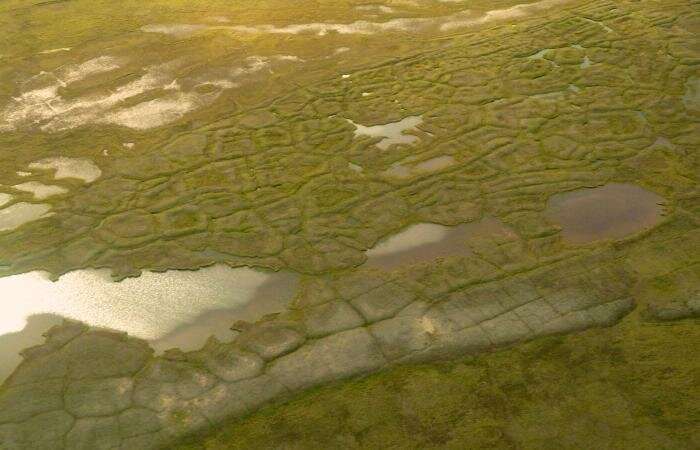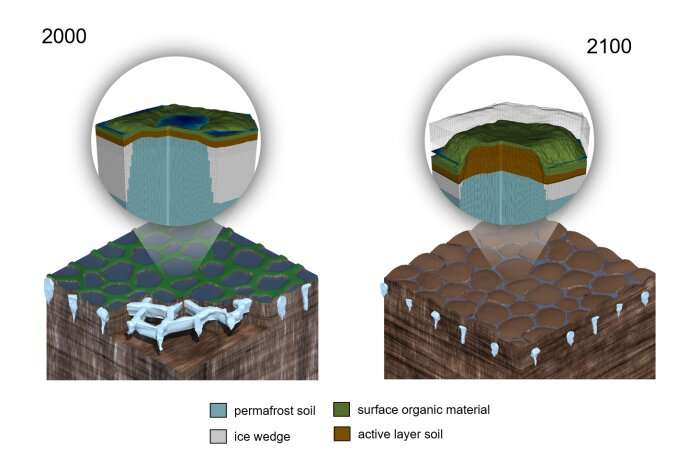This article has been reviewed according to Science X's editorial process and policies. Editors have highlighted the following attributes while ensuring the content's credibility:
fact-checked
peer-reviewed publication
trusted source
proofread
Study finds sinking tundra surface unlikely to trigger runaway permafrost thaw

Oak Ridge National Laboratory scientists set out to address one of the biggest uncertainties about how carbon-rich permafrost will respond to gradual sinking of the land surface as temperatures rise. Using a high-performance computer simulation, the research team found that soil subsidence is unlikely to cause rampant thawing in the future.
This permanently frozen landscape in the Arctic tundra, which has kept vast amounts of carbon locked away for thousands of years, is at risk of thawing and releasing greenhouse gases into the atmosphere.
The United Nation's Intergovernmental Panel on Climate Change has identified the possibility of soil subsidence leading to a feedback loop that could trigger a rapid thaw as a major concern in the decades ahead. Accelerated thawing caused by uneven land subsidence has been observed on smaller scales over shorter time frames, but the IPCC's assessments were uncertain as to what may happen over the long term.
That's where ORNL stepped in with its Advanced Terrestrial Simulator, or ATS, a highly accurate, physics-based model of the region's hydrology fed by detailed, real-world measurements to help scientists understand the land's evolution.
What they found is that even though the ground will continue to sink as big ice deposits melt, the uneven subsidence also leads to a drier landscape and limits the process's acceleration through the end of the century, as described in the Proceedings of the National Academy of Sciences.
"Improved drainage results in a drier landscape over a decadal timescale, and the process then becomes self-limiting," said Scott Painter, who leads the Watershed Systems Modeling group at ORNL.

The scientists focused on a large region of the tundra characterized by ice wedges—long pieces of ice that crack the surface and extend belowground to create polygonal forms in the Arctic landscape. The cryo-hydrology simulations were informed by measurements gathered in the polygonal tundra.
The ATS was first developed for the Department of Energy's NGEE Arctic project led by ORNL, focused on observations, experiments and modeling of the environmental processes at play in the region to improve climate predictions.
"We looked at the microtopography caused by these ice wedges in the subsurface and how that controls the flow of water," Painter said. "Ours is the first capability to capture the effect of changing microtopography and represent it in climate models."
Painter added that the team has a high degree of confidence in the model since it was developed for NGEE Arctic and has been evaluated against the project's real-world observations.
He noted that most models, including ORNL's, are in agreement in generally projecting large amounts of carbon thaw in the Arctic as temperatures rise. "But here, we have identified that one of the most worrisome processes, this runaway thawing due to subsidence, is unlikely to occur over a long time frame."
The study pointed out other implications of a drying landscape. "As the polygonal tundra gets very dry, by the year 2100 it could have ecological impacts for migratory birds, which use these ecosystems as breeding grounds," Painter said.
More information: Scott L. Painter et al, Drying of tundra landscapes will limit subsidence-induced acceleration of permafrost thaw, Proceedings of the National Academy of Sciences (2023). DOI: 10.1073/pnas.2212171120
Journal information: Proceedings of the National Academy of Sciences
Provided by Oak Ridge National Laboratory


















